Goldfish diseases
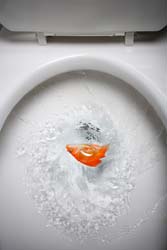
Milkshake here again. Look at the picture: Horrifying, ain't it? I bet that you don't want your fish to die, so here are the goldfish diseases to watch out for, and how to treat them! So long little dude...
Fin rot
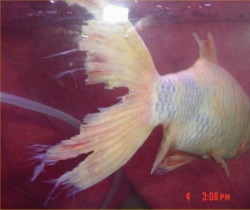
Fin fot is a common goldfish disease. Don't worry, it is easily treated, but to make sure the fin rot doesn't come back, investigate the source. Fin rot is caused by stress, which can be caused by handling to much, infrequent cleaning, overcrowding, not enough oxygen, and strange conditions. To know if your pet has fin rot, you will notice a white cloudiness around your fish's fins. The fins will be ragged and tattered. The fin rot will destroy the fin tissue un til it reaches the fin base. Fin tissue can be grown back, but if you don't treat it before it reaches your fish's body, theres a strong chance it won't grow back. To treat it, if your fish has th fungus infection of fin rot, (white cloudiness) then you will need to use a Q-tip to dap some green malachite where the cloudiness is. Apply more if needed. However, if your pet has the bactirial infection, antibiotics can be added to the water, or even anti biotic food.
Goldfish fungus
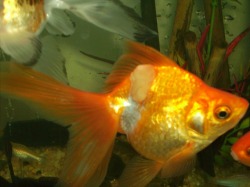
Goldfish Fungus is caused by saprolagnia or Achlya. You will know that your goldfish has fungus when they have ''fluffy spots'' on their bodies. They mostly are under the fins and under the scales. Fungus comes after your goldfish has already been weakened by another disease, such as ick or white spot. Fungus eat your fish alive! Then it releases more into the water, starting it all over again. If your goldfish has fungus, you should have kept the tank clean. Goldfish don't get fungus if their tanks are clean. This disease is deadly to your fish, so treat quickly. To treat, Methylane blue can be added to the water for treatment
Dropsy
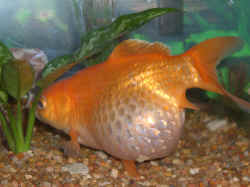
You will know when your fish has dropsy when you see him/her start sweelin up. When the infection is very bad, your pet can swell so much that it's scales start to stick out and its eyes are popping out too. Goldfish dropsy is caused because bacteria is attacking the kidneys and liver, causing swelling in the organs and body tissue, and excess fluids began to build up. To treat, add some 1/8 Espon salts every 5 gallons and make the water at room temperature. Also make sure the water is clean.
pop-eye disease
This goldfish disease means that your goldfish's eyes are popping out of it's head. Remember, some goldfish are bred to have protruding eyes, such as the black moor, or the telescope eye. But if your goldfish's eyes stick out more than usual, you know something is wrong. This disease can be caused by several things, like the starting of dropsy, parasites, bacterial infections, and tuberculosis. Don't worry, this disease is easily treated. To treat, put anibiotics in the water to help.
Anchor worm
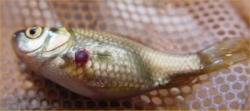
This is something to look out for. Anchor worms are parasites, and you may see white, black, or browd ''threads'' hanging from them. The female anchor worm has a head shaped like a hook, used to attach herself to your poor pet. Your goldfish will try to get rid of it by rubbing up against ornaments. This doesn't stop the worm. The female anchor worm will reproduce, and the new anchor worms will began to feed on your pet. They even stay attached to the goldfish even when they are dead. Dimilin is the cure. It is a liquid that can be added to your goldfish's water, and will kill the parasites, but won't harm your fish or plants.
Fish lice
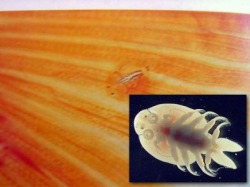
Fish lice can be hard to detect, because they are clear so they appear to be the color of your goldfish. They have needle-sharp teeth to bite into your goldfish. From the spots that the lice have bitten into, the bites can easily become infected. The female loves to lay her eggs on hard surfaces in the aquarium, so they can multiply fast. She lays hundreds, even thousands of egs in only about 3 weeks. You can add dimilin to the water to stop and kill the lice and save your fish.
Swim-bladder problems
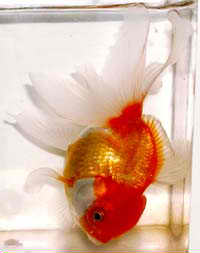
Fatter goldfish are more prone to swim bladder problems. Swim bladder problems cause your fish to swim awkwardly; upside-down, side-ways, vertical, they float to the top, and try to wedge themselves under things to keep themselves on the bottom, and so on. The swim bladder is an organ that is filled with air that helps your fish to swim around. Swim bladder problems are caused by constipation or over-eating. To cure, don't feed it for a few days. Don't worry, they won't starve; goldfish can stay alive without food for over a week. Try feeding them peas, spinach, lettuce or cucumber after those few days are up.
Body and gill flukes
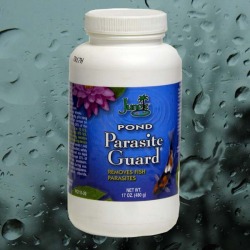
Body and gill flukes are another parasite that can harm your fish. The worms have a hook on one end and will wriggle all over your goldfish to find a good and tasty spot. These parasites probably came from overcrowding, unclean water, and stress. You will know that something is wrong with your fish because he/she will behave different. They will rub up against anything they can find, and flash around the tank in irritation. If not treated, your goldfish will become lethargic and lie in the bottom of the tank with it's fins pulled close to it's body. To treat, a salt bath for 2-3 days will help. After that, you can try an ammonia compound product. Two other things you could try are Malachite and Formalin.
Hole-in-head disease
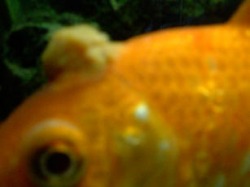
Hole-in-head-disease is a very serious disease, though it has a funny name.It is very obvious to tell if your goldfish has it. The hole(s) will be in the head and nasal area. Pompom goldfish are meant to have large nasal lobes that look like in the picture above, only on their noses. This disease is caused by a protazoa parasite called Heximita. The holes are gray or white. Bad water is what draws the parasites, so keep your water clean! If you rise the water temperature during water changes, and add 1 tablespoon of aquarium salt to every 5-10 gallons of water, this should help your parasite problem.
